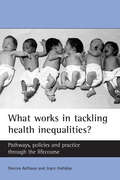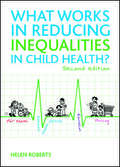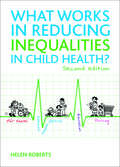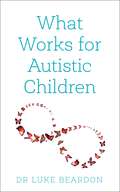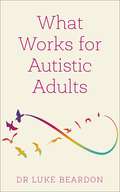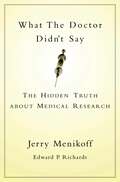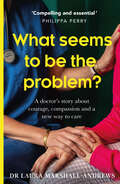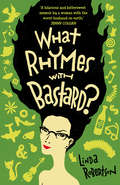- Table View
- List View
What works in tackling health inequalities?: Pathways, policies and practice through the lifecourse (Studies in Poverty, Inequality and Social Exclusion series)
by Sheena Asthana Joyce HallidayIn recent years, tackling health inequalities has become a key policy objective in the UK. However, doubts remain about how best to translate broad policy recommendations into practice. One key area of uncertainty concerns the role of local level initiatives. This book identifies the key targets for intervention through a detailed exploration of the pathways and processes that give rise to health inequalities across the lifecourse. It sets this against an examination of both local practice and the national policy context, to establish what works in health inequalities policy, how and why. Authoritative yet accessible, the book provides a comprehensive account of theory, policy and practice. It spans the lifecourse from the early years to old age and explores the links between biological, psychological, social, educational and economic factors and a range of health outcomes. In addition it describes key policy initiatives, assesses research evidence of 'what works' and examines the limitations of the existing evidence base and highlights key areas of debate. What works in tackling health inequalities? is essential reading for academics and students in medical sociology, social psychology, social policy and public health, and for policy makers and practitioners working in public health and social exclusion.
What works in reducing inequalities in child health 2nd edn.
by Helen RobertsThe UK has a deservedly strong reputation for work on understanding social inequalities in health, but there is some way to go in using research and other types of knowledge to reduce inequalities in child health. This revised and updated edition of an important report looks at macro public policy interventions, community interventions, and individual level interventions in a variety of settings, including infancy, early years, childhood, adolescence, and particular needs including looked after children. It considers 'what works' - or might work - in practice. There are new case studies, updated research references, and new reference to cost effectiveness - all relevant for doing the right thing in a climate of austerity. Drawing on evidence from the UK and beyond, the book presents these in an accessible form, not just for those who make decisions now, but also for the students of today who are the decision makers of tomorrow. The book is supported by a companion website, containing additional materials for both students and lecturers, which is available from the link above.
What Works in Crime Prevention and Rehabilitation: Lessons from Systematic Reviews (Springer Series on Evidence-Based Crime Policy)
by David Weisburd David P. Farrington Charlotte GillThis ambitious volume brings together and assesses all major systematic reviews of the effectiveness of criminological interventions, to draw broad conclusions about what works in policing, corrections, developmental prevention, situational prevention, drug abuse treatments, sentencing and deterrence, and communities.Systematic reviews aim to minimize any possible bias in drawing conclusions by stating explicit criteria for inclusion and exclusion of studies, by conducting extensive and wide-ranging searches for possibly eligible studies, and by making all stages of the review explicit and transparent so that the methods can be checked and replicated. Over a decade ago, a concerted effort was made by members of the criminology community, including the Editors and contributors of this volume, to bring the practice of systematic reviews to the study of Criminology, providing replicable, evidence-based data to answer key questions about the study of crime causation, detection, and prevention. Now, the pioneers in this effort present a comprehensive stock-taking of what has been learned in the past decade of systematic reviews in criminology. Much has been discovered about the effectiveness of (for example) boot camps, “hot spots” policing, closed-circuit television surveillance, neighborhood watch, anti-bullying programs in schools, early parenting programs, drug treatment programs, and other key topics.This volume will be of interest to researchers in criminology and criminal justice, as well as in related fields such as public health and forensic science, with important implications for policy-makers and practitioners.Decisively showing that the “nothing works” era is over, this volume takes stock of what we know, and still need to know, to prevent crime. I plan to keep this book close at hand and to use it often!Francis T. Cullen, Distinguished Research Professor Emeritus, University of Cincinnati At a time when there is a broad commitment to bringing science to the front lines of practice, this book should be on the reading list of both policymakers and scholars.Laurie O. Robinson, Clarence J. Robinson Professor of Criminology, Law Society, George Mason University and former Assistant Attorney General of the U.S. Department of Justice
What Works for Whom?: A Critical Review of Psychotherapy Research (2) (PDF)
by Anthony Roth Peter Fonagy Robert Woods Mary Target Glenys ParryThis acclaimed work provides a systematic, comprehensive, and balanced evaluation of the current status of all major psychotherapeutic approaches. With a primary focus on adults, detailed evidence is presented for the efficacy of widely used interventions for frequently encountered mental disorders and specific populations. The book also explains the concepts that underpin psychotherapy research, examines methodological challenges in translating research into practice, and considers the impact on outcome of factors common to all therapies, such as therapist and patient characteristics.
What Works for Autistic Children
by Luke BeardonImagine a world where your autistic child is included, engaged and cherished for how they are; a world which changes for autistic children, rather than changing the child.What Works for Autistic Children brings the conversation about inclusivity into the forefront and turns it on its head. Instead of modifying the autistic child and making exceptions or special circumstances, Luke shows you, the parent, how the world can, should and must change to accommodate your child. He identifies the aspects that impact on your child's life most - the family, their school, their friends, their environment - and outlines the steps that can and should be taken by everyone involved to improve their outcome and create an autism-friendly landscape.From early communication, through pre-school, primary school, secondary school - on holidays, school trips and with friends - your child should not have to struggle to exist within the parameters of a world they don't understand. What Works for Autistic Children will give you the dialogue, tools and starting points to involve every professional and family member as advocates for a world where your child flourishes.
What Works for Autistic Adults
by Luke Beardon'This book has the power to change lives' Chris PackhamImagine a world where an autistic person is included, engaged and cherished for how they are; a world which changes for autistic people, rather than changing the person.What Works for Autistic Adults brings the conversation about inclusivity into the forefront and turns it on its head. Instead of modifying the autistic individual and making exceptions or special circumstances, Luke shows how the world can, should and must change to accommodate your needs or those of the autistic person you love, live or work with.He identifies the aspects that impact on life most - partners, friends, work or college, and environment - and outlines the steps that can and should be taken by everyone involved to create an autism-friendly landscape and improve outcomes all round. Covering every setting, from social situations to office or other professional environments, and in all circumstances, Luke's book shows how no-one should have to struggle to exist within the parameters of a world they don't understand. What Works for Autistic Adults will give you the dialogue, tools and starting points to involve every loved one, family member or colleague as advocates for a world where you, or any other autistic adult, can truly flourish.
What They Didn’t Teach You at Medical School
by Alan V. ParbhooDuring medical training there are certain tasks that are not taught at medical school nor in the common reference books. There are some skills that medical students are expected to learn by ‘osmosis’. These skills are never officially taught or examined in medical school, but are, however, a fundamental part of being a safe, good and efficient doctor. This book includes ‘golden rules’ or important points to remember and case examples, both of which are given as displayed extracts. This book will help the junior doctor unlock their potential and improve their performance, cutting the time it takes to achieve certain medical objectives. It is meant to fill in the gaps where the medical school and clinical guides stop. It gives the reader the information needed to organise themselves so that they can hit the ground running. It is not intended as a clinical survival guide, but more a friendly hand to allow the reader to get ahead in medicine and how to keep on track and develop a career path.
What the Dying Teach Us: Lessons on Living
by Samuel L Oliver April FordWhat the Dying Teach Us: Lessons on Living is a spiritual approach to health care that teaches the reader about values, hope, and faith through actual experiences of terminally ill persons. This unique approach to health care teaches the living how to deal with grief and the bereavement process through faith and prayer. Priests, pastors, chaplains, and psychotherapists will learn how to treat parishioners or patients with the values the dying leave behind, allowing part of their deceased loved one&’s beliefs and teachings to guide them through the grieving process. In the end, you will also become aware of your spiritual self while helping others heal and renew their soul.While What the Dying Teach Us concentrates on the values you can learn from the terminally ill, the author includes his own views on: how our tears manifest the depth into which our relationship with a deceased loved one travels how dimensions of reality lead us to appreciate the present experiencing events in life without judgment or comparison the role faith may play in health care as a healer of the terminally ill how the strength of prayer can drastically change livesWhat the Dying Teach Us celebrates the spirit loved ones leave behind and teaches you how to surrender into an eternal relationship with them. Furthermore, because of this experience, you will be able to find a new and deeper realization of your own existence. What the Dying Teach Us will help you spiritually connect with yourself as well as with deceased loved ones that continue to live on through faith.
What the Dying Teach Us: Lessons on Living
by Samuel L Oliver April FordWhat the Dying Teach Us: Lessons on Living is a spiritual approach to health care that teaches the reader about values, hope, and faith through actual experiences of terminally ill persons. This unique approach to health care teaches the living how to deal with grief and the bereavement process through faith and prayer. Priests, pastors, chaplains, and psychotherapists will learn how to treat parishioners or patients with the values the dying leave behind, allowing part of their deceased loved one&’s beliefs and teachings to guide them through the grieving process. In the end, you will also become aware of your spiritual self while helping others heal and renew their soul.While What the Dying Teach Us concentrates on the values you can learn from the terminally ill, the author includes his own views on: how our tears manifest the depth into which our relationship with a deceased loved one travels how dimensions of reality lead us to appreciate the present experiencing events in life without judgment or comparison the role faith may play in health care as a healer of the terminally ill how the strength of prayer can drastically change livesWhat the Dying Teach Us celebrates the spirit loved ones leave behind and teaches you how to surrender into an eternal relationship with them. Furthermore, because of this experience, you will be able to find a new and deeper realization of your own existence. What the Dying Teach Us will help you spiritually connect with yourself as well as with deceased loved ones that continue to live on through faith.
What the Doctor Didn't Say: The Hidden Truth about Medical Research
by Jerry Menikoff Edward P. RichardsMillions of people each year decide to participate in clinical trials--medical research studies involving an innovative treatment for a medical problem. For the patient, such participation can sometimes be a life-saving choice. But it can also be just the opposite. Our country years ago adopted rules designed to assure that people are making informed choices about participation. This book explains the reality behind those rules: that our current system of clinical trials hides much of the information patients need to make the right choices. Witness the following scenarios: -Hundreds of patients with colon cancer undergo a new form of keyhole surgery at leading cancer centers--never being told that 85% of colorectal surgeons, worried that it increases the risk of the cancer returning, would not themselves undergo that procedure. -Tens of thousands of women at high risk of developing breast cancer are asked to participate in a major research study. They are told about the option of having both breasts surgically removed--but not told about the option of taking a standard osteoporosis pill that might cut the risk of getting breast cancer by one-half or more. What The Doctor Didn't Say, principally written by a nationally prominent expert, is the first book to reveal many heretofore hidden aspects about the true nature of participation in clinical trials. It shows why options not commonly known--including getting a new treatment outside of a research study--can often be the best choice. It explains how patients can make good decisions even if there is only limited information about a treatment's effect. And it does this through the eye-opening stories of what is happening daily to thousands of people. This book ends up confronting the fundamental dilemma of medical research: Participation in clinical trials plays a vital role in advancing knowledge, and many experts fear that if the information provided herein became widely known, fewer people would participate. But the authors demonstrate that there is no need to deceive people into participating in research. We can have a system that promotes participation while still providing truthful information to participants.
What the Apothecary Ordered: Questionable Cures Through The Ages
by Caroline RanceTroubled by toothache? Dogged by dipsomania? Perhaps you have been poisoned or accidentally got a bottle stuck up your bottom? This compendium of tried and tested (and terrifying) historical remedies is your go-to guide for how not to seek medical relief. From smearing mouse-dung on your teeth to drinking sulphuric acid, and from mechanical chin-reducing contraptions to 'super-super-excellent' quack medicines, here are to be found the most bizarre and alarming remedies of the last two thousand years. Spanning Ancient Greece and twentieth century Britain and America, What the Apothecary Ordered positively haemorrhages with the dangerous ministrations of 'healers' of yore. Everyday illnesses, beauty, surgery, sexual performance and madness – whatever the nature of the malady, here the reader will find a cautionary tale about entrusting oneself to the experts.
What Seems to be the Trouble?: Stories in Illness and Healthcare
by Trisha Greenhalgh Merrill GooznerThis is published in association with the Nuffield Trust. There is a foreword By Sir Kenneth Calman Vice Chancellor, Durham University and former Chief Medical Officer. 'Excellent. [The book's] analytical and methodological approach is invaluable. It is a real privilege to listen to the stories of patients and their families, to hear details of personal events, comedies and tragedies, and to use the skills of listening and interpreting to make sense of the story. I have written elsewhere that the history of medicine is simply the re-classification of disease. Here are some new ways of classifying the issues with which we are faced in an effort to assist in the process of healing.' - Sir Kenneth Calman, in the Foreword.
What Seems to be the Trouble?: Stories in Illness and Healthcare
by Trisha Greenhalgh Merrill GooznerThis is published in association with the Nuffield Trust. There is a foreword By Sir Kenneth Calman Vice Chancellor, Durham University and former Chief Medical Officer. 'Excellent. [The book's] analytical and methodological approach is invaluable. It is a real privilege to listen to the stories of patients and their families, to hear details of personal events, comedies and tragedies, and to use the skills of listening and interpreting to make sense of the story. I have written elsewhere that the history of medicine is simply the re-classification of disease. Here are some new ways of classifying the issues with which we are faced in an effort to assist in the process of healing.' - Sir Kenneth Calman, in the Foreword.
What Seems To Be The Problem?
by Dr Laura Marshall-Andrews‘Compelling and essential . . . will appeal to everyone who enjoyed Adam Kay’s This Is Going to Hurt’ Philippa Perry
What Rhymes with Bastard?
by Linda RobertsonThe hilariously candid story of an unbelievably dysfunctional and disintegrating relationship.
What Really Works: The Insider's Guide To Complementary Health
by Susan ClarkConsumer guide to what’s best in complementary health, from products to therapies.
What Radiology Residents Need to Know: Musculoskeletal Radiology (What Radiology Residents Need to Know)
by Ronald L. EisenbergThis book is an introduction to musculoskeletal radiology, specifically designed for the needs of first-year residents. On the first rotation in musculoskeletal imaging, radiology residents are asked to learn significant amounts of information at a fast and unrelenting pace. However, most current books are densely written and contain far more material than residents need to know. Moreover, the number, variety and quality of images is often limited.What Radiology Residents Need to Know: Musculoskeletal Radiology answers these needs by presenting the important information in bullet fashion, divided into convenient sub-units, such as “clinical information,” “imaging findings,” and “management.” In most cases, an individual pathological condition can be presented in one page or less. In addition, it contains tips on approaching and interpreting radiographs, MRI and CT based on decades of practical experience and teaching residents at the work station.With liberal use of illustrations in the text and an online bank of many more high-quality images, this book gives readers a comprehensive library of musculoskeletal imaging scans and serves as an ideal guide for radiology residents.
What Radiology Residents Need to Know: Chest Radiology
by Ronald L. EisenbergThis book is an introduction to chest radiology, specifically designed for the needs of first-year residents. On the first rotation in chest imaging, radiology residents are asked to learn significant amounts of information at a fast and unrelenting pace. However, most current books are densely written and contain far more material than residents need to know. Moreover, the number, variety, and quality of images is often limited. What Radiology Residents Need to Know: Chest Radiology answers these needs by presenting the important information in bullet fashion, divided into convenient sub-units, such as “clinical information,” “imaging findings,” and “management.” In most cases, an individual pathological condition can be presented in one page or less. This book covers such topics as volume loss, pneumonia, pulmonary edema, inhalation diseases, and pulmonary, mediastinal, and pleural tumor imaging. In addition, it contains tips on approaching and interpreting chest radiographs and CT based on decades of practical experience and teaching residents at the work station. With liberal use of illustrations in the text and an online bank of many more high-quality images, this book gives readers a comprehensive library of chest imaging scans and serves as an ideal guide for radiology residents.
What Patients Teach: The Everyday Ethics of Health Care
by Larry R. Churchill Joseph B. Fanning David SchenckBeing a patient is a unique interpersonal experience but it is also a universal human experience. The relationships formed when we are patients can also teach some of life's most important lessons, and these relationships provide a special window into ethics, especially the ethics of healthcare professionals. This book answers two basic questions: As patients see it, what things allow relationships with healthcare providers to become therapeutic? What can this teach us about healthcare ethics? This volume presents detailed descriptions and analyses of 50 interviews with 58 patients, representing a wide spectrum of illnesses and clinician specialties. The authors argue that the structure, rhythm, and horizon of routine patient care are ultimately grounded in patient vulnerability and clinician responsiveness. From the short interview segments, the longer vignettes and the full patient stories presented here emerge the neglected dimensions of healthcare and healthcare ethics. What becomes visible is an ethics of everyday interdependence, with mutual responsibilities that follow from this moral symbiosis. Both professional expressions of healthcare ethics and the field of bioethics need to be informed and reformed by this distinctive, more patient-centered, turn in how we understand both patient care as a whole and the ethics of care more specifically. The final chapters present revised codes of ethics for health professionals, as well as the implications for medical and health professions education.
What Nostalgia Was: War, Empire, and the Time of a Deadly Emotion (Chicago Studies in Practices of Meaning)
by Thomas DodmanNostalgia today is seen as essentially benign, a wistful longing for the past. This wasn't always the case, however: from the late seventeenth century through the end of the nineteenth, nostalgia denoted a form of homesickness so extreme that it could sometimes be deadly. What Nostalgia Was unearths that history. Thomas Dodman begins his story in Basel, where a nineteen-year-old medical student invented the new diagnosis, modeled on prevailing notions of melancholy. From there, Dodman traces its spread through the European republic of letters and into Napoleon's armies, as French soldiers far from home were diagnosed and treated for the disease. Nostalgia then gradually transformed from a medical term to a more expansive cultural concept, one that encompassed Romantic notions of the aesthetic pleasure of suffering. But the decisive shift toward its contemporary meaning occurred in the colonies, where Frenchmen worried about racial and cultural mixing came to view moderate homesickness as salutary. An afterword reflects on how the history of nostalgia can help us understand the transformations of the modern world, rounding out a surprising, fascinating tour through the history of a durable idea.
What Nostalgia Was: War, Empire, and the Time of a Deadly Emotion (Chicago Studies in Practices of Meaning)
by Thomas DodmanNostalgia today is seen as essentially benign, a wistful longing for the past. This wasn't always the case, however: from the late seventeenth century through the end of the nineteenth, nostalgia denoted a form of homesickness so extreme that it could sometimes be deadly. What Nostalgia Was unearths that history. Thomas Dodman begins his story in Basel, where a nineteen-year-old medical student invented the new diagnosis, modeled on prevailing notions of melancholy. From there, Dodman traces its spread through the European republic of letters and into Napoleon's armies, as French soldiers far from home were diagnosed and treated for the disease. Nostalgia then gradually transformed from a medical term to a more expansive cultural concept, one that encompassed Romantic notions of the aesthetic pleasure of suffering. But the decisive shift toward its contemporary meaning occurred in the colonies, where Frenchmen worried about racial and cultural mixing came to view moderate homesickness as salutary. An afterword reflects on how the history of nostalgia can help us understand the transformations of the modern world, rounding out a surprising, fascinating tour through the history of a durable idea.
What Nostalgia Was: War, Empire, and the Time of a Deadly Emotion (Chicago Studies in Practices of Meaning)
by Thomas DodmanNostalgia today is seen as essentially benign, a wistful longing for the past. This wasn't always the case, however: from the late seventeenth century through the end of the nineteenth, nostalgia denoted a form of homesickness so extreme that it could sometimes be deadly. What Nostalgia Was unearths that history. Thomas Dodman begins his story in Basel, where a nineteen-year-old medical student invented the new diagnosis, modeled on prevailing notions of melancholy. From there, Dodman traces its spread through the European republic of letters and into Napoleon's armies, as French soldiers far from home were diagnosed and treated for the disease. Nostalgia then gradually transformed from a medical term to a more expansive cultural concept, one that encompassed Romantic notions of the aesthetic pleasure of suffering. But the decisive shift toward its contemporary meaning occurred in the colonies, where Frenchmen worried about racial and cultural mixing came to view moderate homesickness as salutary. An afterword reflects on how the history of nostalgia can help us understand the transformations of the modern world, rounding out a surprising, fascinating tour through the history of a durable idea.
What Nostalgia Was: War, Empire, and the Time of a Deadly Emotion (Chicago Studies in Practices of Meaning)
by Thomas DodmanNostalgia today is seen as essentially benign, a wistful longing for the past. This wasn't always the case, however: from the late seventeenth century through the end of the nineteenth, nostalgia denoted a form of homesickness so extreme that it could sometimes be deadly. What Nostalgia Was unearths that history. Thomas Dodman begins his story in Basel, where a nineteen-year-old medical student invented the new diagnosis, modeled on prevailing notions of melancholy. From there, Dodman traces its spread through the European republic of letters and into Napoleon's armies, as French soldiers far from home were diagnosed and treated for the disease. Nostalgia then gradually transformed from a medical term to a more expansive cultural concept, one that encompassed Romantic notions of the aesthetic pleasure of suffering. But the decisive shift toward its contemporary meaning occurred in the colonies, where Frenchmen worried about racial and cultural mixing came to view moderate homesickness as salutary. An afterword reflects on how the history of nostalgia can help us understand the transformations of the modern world, rounding out a surprising, fascinating tour through the history of a durable idea.
What Nostalgia Was: War, Empire, and the Time of a Deadly Emotion (Chicago Studies in Practices of Meaning)
by Thomas DodmanNostalgia today is seen as essentially benign, a wistful longing for the past. This wasn't always the case, however: from the late seventeenth century through the end of the nineteenth, nostalgia denoted a form of homesickness so extreme that it could sometimes be deadly. What Nostalgia Was unearths that history. Thomas Dodman begins his story in Basel, where a nineteen-year-old medical student invented the new diagnosis, modeled on prevailing notions of melancholy. From there, Dodman traces its spread through the European republic of letters and into Napoleon's armies, as French soldiers far from home were diagnosed and treated for the disease. Nostalgia then gradually transformed from a medical term to a more expansive cultural concept, one that encompassed Romantic notions of the aesthetic pleasure of suffering. But the decisive shift toward its contemporary meaning occurred in the colonies, where Frenchmen worried about racial and cultural mixing came to view moderate homesickness as salutary. An afterword reflects on how the history of nostalgia can help us understand the transformations of the modern world, rounding out a surprising, fascinating tour through the history of a durable idea.
